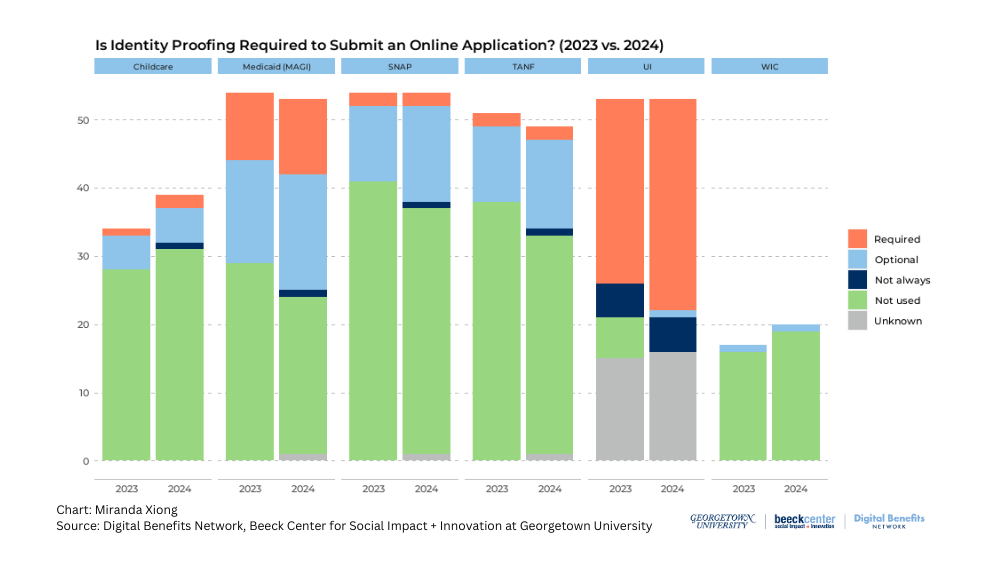Digital Benefits Network Releases Updated Data on Digital Identity in Public Benefits
Today, the Digital Benefits Network is releasing an updated version of our “Digital Identity in Public Benefits” Dataset. First published in 2023, this project examines online applications across the United States for six programs: Supplemental Nutrition Assistance Program (SNAP), Temporary Assistance for Needy Families (TANF), Medicaid, Special Supplemental Nutrition Program for Women, Infants, and Children (WIC), Child Care Assistance (CCAP), and Unemployment Insurance (UI) to understand when and how states use account creation, authentication, and identity proofing in initial online public benefits applications.
When people across the United States apply for public benefits online, they may be asked to create a username and account and, in some cases, prove who they are by verifying their identity. In our review of online benefits applications we ask a variety of questions, focused on understanding: when and how states use account creation, authentication, and identity proofing in initial online public benefits applications.
The way state agencies structure online account creation processes and requirements for applicants and beneficiaries to prove their identities may impact access to essential public benefits, and how quickly individuals can apply for and start receiving those benefits. By documenting the landscape of practices, this project aims to help the broad ecosystem of federal agencies, advocates, academics, and civic tech organizations identify states that are taking unique, unusual, or potentially promising approaches. Through this project, we’re also identifying states that may be putting up potential barriers through account creation, authentication, and identity proofing.
We’re excited to publish a fully updated version of this dataset to help stakeholders understand what has changed since 2023, where there are new approaches being used, and where opportunities for improvement remain. With today’s release of the open dataset, we’re lifting up some of our key findings. In early 2025, we will also publish program-specific analysis to enable practitioners to explore the digital identity landscape in a given program, like SNAP or unemployment insurance.
Key Takeaways:
Identity proofing
- Across programs, we found slightly more applications requiring identity proofing in 2024, up from 37 applications in 2023 to 42 in 2024.
- Identity proofing requirements or prompts remain most common in unemployment insurance applications, but we saw more state workforce agencies incorporating additional pathways for identity proofing (e.g., adding in-person options for identity verification through the USPS, or through use of kiosks for in-person identity verification).
- Five states also added optional identity proofing to their online integrated benefits applications.

Account creation
- We saw similar numbers of applications requiring applicants to create an account to apply online in 2023 vs. 2024. Account creation requirements remain most common in unemployment insurance applications. However, across programs, we saw more online applications using optional account creation in 2024 than in 2023.

New applications + programs online
- Several states made more benefits programs available online, either by creating new standalone applications or by adding more programs to their integrated online benefits applications.
- Highlights include Alaska’s newly online SNAP application and four newly online WIC applications or pre-applications. Six states also added online child care applications, either as standalone applications or as additions to their integrated benefits portals.

Digital identity choice
- As we’ve previously written, one of the things we think is most important when it comes to digital identity in public benefits is choice. Recognizing that beneficiaries and applicants have different levels of comfort with and access to technology, administering agencies can offer beneficiaries and applicants choices about when and how to create accounts or verify their identities, if those identity management steps are relevant for a particular online interaction.

For more in-depth analysis, additional resources related to digital identity in public benefits, and to learn about our research approach, visit the Digital Government Hub.
Get Involved
Digital Identity Community of Practice
We know that understanding the current landscape is only the first step in improving how digital identity is used to promote access and security in public benefits applications. We also have to better understand what works for beneficiaries and applicants, identify shared challenges, and work to implement human-centered approaches in benefits delivery.
In 2024, the DBN announced a new community of practice focused on digital identity in public benefits. The mission of this cross-sector community is to promote the delivery of public benefits to all eligible individuals, including vulnerable populations, by informing how digital identity approaches should be used in public benefits delivery. Learn more and join on the Digital Government Hub.
Collaborative Research
The DBN is also partnering with the National Institute of Standards and Technology (NIST) and the Center for Democracy and Technology (CDT) to tailor NIST’s Digital Identity Guidelines to the unique access considerations of public benefits programs, specifically integrated applications that include SNAP and Medicaid. Read more about this project and get involved on the Digital Government Hub.